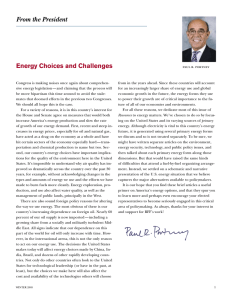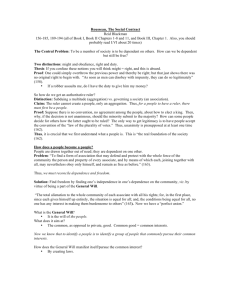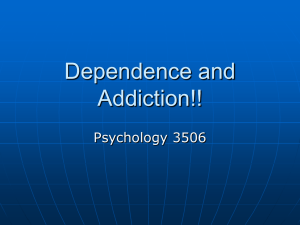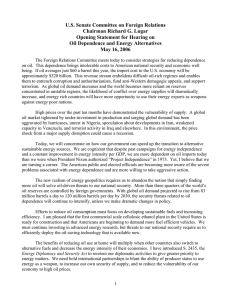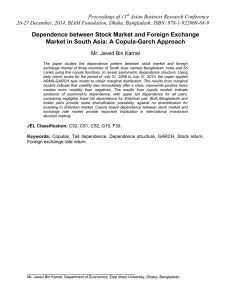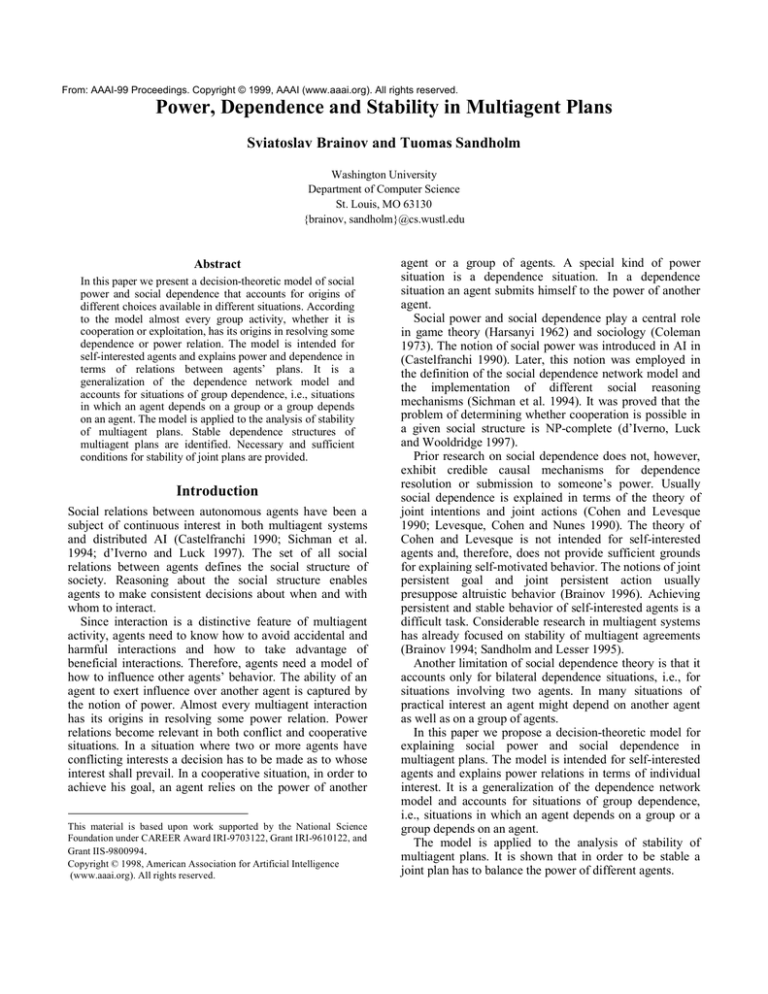
From: AAAI-99 Proceedings. Copyright © 1999, AAAI (www.aaai.org). All rights reserved.
Power, Dependence and Stability in Multiagent Plans
Sviatoslav Brainov and Tuomas Sandholm
Washington University
Department of Computer Science
St. Louis, MO 63130
{brainov, sandholm}@cs.wustl.edu
Abstract
In this paper we present a decision-theoretic model of social
power and social dependence that accounts for origins of
different choices available in different situations. According
to the model almost every group activity, whether it is
cooperation or exploitation, has its origins in resolving some
dependence or power relation. The model is intended for
self-interested agents and explains power and dependence in
terms of relations between agents’ plans. It is a
generalization of the dependence network model and
accounts for situations of group dependence, i.e., situations
in which an agent depends on a group or a group depends
on an agent. The model is applied to the analysis of stability
of multiagent plans. Stable dependence structures of
multiagent plans are identified. Necessary and sufficient
conditions for stability of joint plans are provided.
Introduction
Social relations between autonomous agents have been a
subject of continuous interest in both multiagent systems
and distributed AI (Castelfranchi 1990; Sichman et al.
1994; d’Iverno and Luck 1997). The set of all social
relations between agents defines the social structure of
society. Reasoning about the social structure enables
agents to make consistent decisions about when and with
whom to interact.
Since interaction is a distinctive feature of multiagent
activity, agents need to know how to avoid accidental and
harmful interactions and how to take advantage of
beneficial interactions. Therefore, agents need a model of
how to influence other agents’ behavior. The ability of an
agent to exert influence over another agent is captured by
the notion of power. Almost every multiagent interaction
has its origins in resolving some power relation. Power
relations become relevant in both conflict and cooperative
situations. In a situation where two or more agents have
conflicting interests a decision has to be made as to whose
interest shall prevail. In a cooperative situation, in order to
achieve his goal, an agent relies on the power of another
This material is based upon work supported by the National Science
Foundation under CAREER Award IRI-9703122, Grant IRI-9610122, and
Grant IIS-9800994.
Copyright © 1998, American Association for Artificial Intelligence
(www.aaai.org). All rights reserved.
agent or a group of agents. A special kind of power
situation is a dependence situation. In a dependence
situation an agent submits himself to the power of another
agent.
Social power and social dependence play a central role
in game theory (Harsanyi 1962) and sociology (Coleman
1973). The notion of social power was introduced in AI in
(Castelfranchi 1990). Later, this notion was employed in
the definition of the social dependence network model and
the implementation of different social reasoning
mechanisms (Sichman et al. 1994). It was proved that the
problem of determining whether cooperation is possible in
a given social structure is NP-complete (d’Iverno, Luck
and Wooldridge 1997).
Prior research on social dependence does not, however,
exhibit credible causal mechanisms for dependence
resolution or submission to someone’s power. Usually
social dependence is explained in terms of the theory of
joint intentions and joint actions (Cohen and Levesque
1990; Levesque, Cohen and Nunes 1990). The theory of
Cohen and Levesque is not intended for self-interested
agents and, therefore, does not provide sufficient grounds
for explaining self-motivated behavior. The notions of joint
persistent goal and joint persistent action usually
presuppose altruistic behavior (Brainov 1996). Achieving
persistent and stable behavior of self-interested agents is a
difficult task. Considerable research in multiagent systems
has already focused on stability of multiagent agreements
(Brainov 1994; Sandholm and Lesser 1995).
Another limitation of social dependence theory is that it
accounts only for bilateral dependence situations, i.e., for
situations involving two agents. In many situations of
practical interest an agent might depend on another agent
as well as on a group of agents.
In this paper we propose a decision-theoretic model for
explaining social power and social dependence in
multiagent plans. The model is intended for self-interested
agents and explains power relations in terms of individual
interest. It is a generalization of the dependence network
model and accounts for situations of group dependence,
i.e., situations in which an agent depends on a group or a
group depends on an agent.
The model is applied to the analysis of stability of
multiagent plans. It is shown that in order to be stable a
joint plan has to balance the power of different agents.
The paper is organized as follows. First, the notion of
dependence is introduced and generalized to the case of
more than two agents. Next, the resolution of dependence
relations is discussed. Finally, the notion of dependence is
applied in the analysis of stability of multiagent plans. The
paper concludes by summarizing the results and providing
directions for future research.
Unilateral Dependence
Let the set of all agents be denoted by N, N={1,2,…,n}.
The n-tuple (p1,p2,…,pn) is used to denote a joint plan of all
agents for moving the world from the initial state s1 to
some final state sr. Here pi stands for the individual subplan
of agent i. Each agent’s subplan can be viewed as a
sequence of actions: pi=(ai1,…,air-1) such that every n-tuple
[a1k,…,ank], possibly with some precedence constraints
between pairs (aik,ajk), moves the world from a state sk to
the state sk+1. As usual, agents are utility maximizers and
each agent i, i∈N, attempts to maximize his utility Ui in the
final state. Let pN-i denote the plan of the group of agents
N-{i}. In this notation we can write the plan (p1,p2,…,pn) as
(pN-i, pi).
The following definition introduces the notion of
individual dependence, i.e., an agent’s dependence on
another agent in some joint plan.
Definition 1. In a joint plan (pN-j,pj) agent i depends on
agent j if there exists plan p*j such that for every plan p’N-j
of the other agents:
Ui(p’N-j,p*j) < Ui(pN-j,pj),
(1)
Uj(pN-j,p*j) ≥ Uj(pN-j,pj).
(2)
The plan p*j is said to be gainful for agent j at the expense
of agent i. To indicate that the gainful plan depends on the
initial plan (pN-j,pj), we denote it by pjgain(i,pN-j,pj).
Condition (1) says that by implementing his plan p*j,
agent j lowers the utility of agent i. According to Condition
(2) the plan p*j is at least as beneficial to agent j as the
original plan pj, provided that the other agents do not
change their plans. The situation described by Definition 1
can be classified as one where agent j has social power
(Harsanyi 1962). The plan p*j serves as the means of
power, i.e., those specific actions by which agent j can
influence agent i’s behavior. According to Condition (2)
the cost of power is zero or negative. That is, agent j does
not incur any additional costs in order to exert any
influence over agent i. Therefore, with each unilateral
power situation we can associate two features: the means
of power and the cost of power. The means of power is the
particular plan by which the powerful agent can exert his
power over the dependent agent. The cost of power is the
cost of applying the means of power.
Condition (1) of Definition 1 holds for every plan p’N-j of
the other agents. That is, no matter how other agents will
help agent i, they cannot prevent agent j from harming
agent i. Therefore, the power of agent j with respect to
agent i is unconditional and does not depend on other
agents. The notion of dependence introduced in Definition
1 generalizes traditional concepts of resource and action
dependence (Sichman et al. 1994). Consider the following
example. Agent i needs a resource rj for achieving his goal,
i.e., without rj agent i is either incapable of achieving his
goal or the achievement is too costly. The only agent who
controls resource rj is agent j. Suppose that agent j has
committed himself to give rj to agent i at some stage of the
joint plan (pN-j,pj). If the commitment is not binding, agent j
can deviate from the plan (pN-j,pj) by withholding rj to
himself. By so doing, agent j gains at the expense of agent
i. Therefore, agent i depends on agent j. Thus, the notion of
resource dependence is a special case of dependence. It is
worth noting that the other agents in the environment
cannot oppose agent j. Eventually, they could punish agent
j for his behavior, but they cannot provide agent i with a
resource equivalent or better than rj.
The traditional notion of resource (action) dependence
does not account for the case when a resource (action) can
be provided by several agents. Suppose that in the previous
example resource rj can be provided by agent j or agent k.
According to the traditional notion of resource dependence
agent i depends on agent j for rj. If agent j deviates from
the plan (pN-j,pj) by withholding rj to himself, agent i can
still receive the resource from agent k. Therefore, in
accordance with Definition 1, in this case agent i does not
depend on agent j. Later we will classify this situation as
conditional dependence of agent i on agent j with the tacit
consent of agent k. That is, agent i might depend on agent j
if agent k is backing up agent j.
Group Dependence
In this section the notion of dependence is generalized to
the case where there are more than two agents. The
existence of other agents in an environment gives rise to
different types of group dependence. The next definition
introduces the transitive closure of a dependence relation.
Definition 2. In a joint plan p=(p1,…,pn) agent i, i∈N,
depends transitively on agent j, j∈N, if
(i)
agent i depends on agent j, or
(ii)
there exists agent k, k∈N, such that agent i
depends on agent k and agent k depends
transitively on agent j.
With the help of transitive dependence we are now in a
position to define reciprocal dependence, i.e., a situation in
which everybody depends on everybody directly or
indirectly.
Definition 3. A joint plan p=(p1,…,pn) is based on
reciprocal dependence if for every two agents i and j,
i,j∈N, j≠j, agent i depends transitively on agent j in the
plan p.
Dependence structure of a joint plan can be represented
by a dependence graph (Brainov 1994; Sichman et al.
1994). The dependence graph is constructed in the
following way. The agents are represented by nodes and if
I and J are two nodes corresponding to agents i and j
respectively, these two nodes are joined by an arc pointing
toward J if and only if agent i depends on agent j. It is
evident that a joint plan is based on reciprocal dependence
if and only if the dependence graph associated with it is
strongly connected.
The following definition introduces the notion of group
dependence. In this paper we consider two types of group
dependence. The first type refers to the case where a group
of agents depends on a single agent. The second type
occurs when an agent depends on a group
Definition 4. In a joint plan (pN-j,pj) a group of agents S,
S⊆N-j, depends on agent j if there exists a plan p*j such
that for every plan p’N-j of the other agents:
Uk(p’N-j,p*j) < Uk(pN-j,pj) for every k∈S
Uj(pN-j,p*j) ≥ Uj(pN-j,pj).
The plan p*j is said to be gainful for agent j at the expense
of group S. To indicate that the gainful plan depends on the
initial plan (pN-j,pj), we denote it by pjgain(S,pN-j,pj).
Definition 4 requires that plan p*j be common for all
agents of the group S. If every agent in S depended on j for
a different plan, then he would be able to resolve his
dependence separately and without the help of the other
members of the group. In this case there would not be
sufficient grounds to regard agents in S as a group.
Therefore, if every agent in the set of agents S depends on
agent j, we cannot conclude that S depends on j. That is,
individual dependence does not imply group dependence.
The opposite statement, however, is true.
Proposition 1. If in a joint plan (pN-j,pj) a group of agents S,
S⊆N-j, depends on agent j, then every member of the
group depends on agent j.
Since the proofs of most of the propositions require
considerable technical preparation and space, in this
version of the paper the proofs are omitted. The complete
proofs are provided in (Brainov, 1998).
The notion of dependence formalizes power situations in
which the ability of an agent to influence other agents is
unconditional and does not depend on the will or abilities
of third parties. Many situations of practical importance,
however, exhibit constrained power. In such situations
several agents have power over an agent or group of
agents. That is, the power of each powerful agent is
constrained by the other powerful agents. Since the actions
of the powerful agents interfere, the final effect on the
dependent agent is determined by a strategic interaction
between the powerful agents.
The next definition introduces the notion of conditional
dependence. In a situation of conditional dependence, a
powerful agent needs the consent of all other powerful
agents in order to influence the dependent agent.
Definition 5. In a joint plan (pN-S-j,pS, pj) agent i depends
conditionally on agent j with the tacit consent of a group S,
i∉S, if there exists p*j such that for every p’N-S-j:
Ui(p’N-S-j,pS,p*j) < Ui(pN-S-j,pS,pj)
Uj(pN-S-j,pS,p*j) ≥ Uj(pN-S-j,pS,pj).
The plan p*j is called conditionally gainful for agent j and
is denoted by pjgain(i,pN-S-j,pS,pj/pS).
In Definition 5 the powerful agents are agent j and the
group S. Agent j can gain at the expense of agent i if the
group S adheres to the plan pS. By adhering to pS the group
S does not oppose agent j. Definition 5 says that if we
disregard the existence of group S, agent i depends on
agent j. Therefore, the notion of conditional dependence is
more general and subsumes the notion of dependence.
Consider the previous example where the resource rj
needed by agent i can be provided by agent j or agent k. In
this case, in order to apply their power, agents j and k
depend on each other. If agent j withholds his resource rj,
then agent k can provide agent i with the same resource.
Therefore, in order to harm agent i, agent j needs the
consent of agent k.
Proposition 2. If in a joint plan (pN-j,pj) agent i depends on
agent j, then agent i depends conditionally on agent j with
the tacit consent of every group S, S⊆N-i-j.
Proposition 2 is in accordance with the intuition that if
an agent has unconstrained power over another agent, then
the consent of the other agents in the environment is
unnecessary.
Definition 6. Agent j can gain without harming agent i in
the plan (pN-j,pj) if there exist p*j and p*i such that for every
p’N-i-j:
Ui(p’N-i-j,p*i, p*j) ≥ Ui(pN-j,pj)
Uj(p’N-i-j,p*i,p*j) > Uj(pN-j,pj).
According to this definition agent i has a reply to the
plan p*j of agent j. Therefore, after agent j has changed his
plan, agent i needs only to adjust his activity in accordance
with the change. For this adjustment, agent i does not rely
on the other agents in the environment. It is evident that if
a joint plan is Pareto optimal, then no agent can gain
without harming the other agents. The opposite statement
is not true. That is, a joint plan might not be Pareto optimal
even if no agent can gain without harming the other agents.
A joint plan is Pareto optimal if there does not exist
another plan which is as good or better for all the agents
and strictly better for at least one agent.
The following definition introduces a second type of
group dependence, viz., the case when an agent depends on
a group of agents.
Definition 7. In a joint plan (pN-j,pj) agent i depends on a
group of agents S, i∉S, if
(i)
(group requirement) agent i depends conditionally
on every agent k, k∈S, with the tacit consent of
the group S-k;
(ii)
(minimality requirement) for every agent k, k∈S,
every
conditionally
gainful
plan
pkgain(i,pN-S,pS-k,pk/pS-k) and every plan p’N-S, it holds
that every agent m, m∈S-k, can gain without
harming
agent
i
in
the
plan
(p’N-S,pS-k,pkgain(i,pN-S,pS-k,pk/pS-k))
Definition 7 is justified by the intuition that only by
acting together can members of the group S help or harm
agent i. Every member of the group acting separately
cannot exert any power over agent i. The first condition of
Definition 7 says that agent k needs the tacit consent of the
rest of the group S in order to gain at the expense of agent
i. The second condition states that the group S is the
minimal group (in the sense of set theoretic inclusion) that
has any power over agent i. That is, every member of S
contributes to the power of the group, i.e., there are no
dummy members.
The following example helps to clarify Definition 7.
Suppose that there are three agents i, j, and k operating in
the blocks world. The goal of agent i is to move block A
from Position 1 to Position 2. Block A is heavy and only
agents j and k acting together can pick it up. Suppose
further that in the joint plan (pi,pj,pk) agents j and k have
committed unilaterally to move block A from Position 1 to
Position 2. It is clear that in the plan (pi,pj,pk) agent i
depends on the group of agents j and k. Both j and k,
however, can deviate unilaterally and gain at the expense
of agent i. Suppose that agent j has already deviated from
his commitment. Since block A will not be moved to
Position 2, damage has been inflicted upon agent i. After
the deviation of agent j, it does not matter to agent i
whether agent k continues to adhere to his commitment.
Since agent j has already deviated, agent k can also deviate
from his commitment and gain without harming agent i.
Thus, in the case of group dependence the first deviating
agent can inflict damage upon the dependent agent. Agents
deviating afterwards can gain without harming the
dependent agent.
After the deviation of agent j, agent i might still depend
on agent k for things other than moving block A. That is,
agent k can still gain at the expense of agent i, but this gain
has nothing to do with the group activity and particularly
with agent j.
The following proposition follows immediately from
Definition 7.
Proposition 3. If in a joint plan (pN-i,pi) agent i depends on
the group of agents S, i∉S, then agent i conditionally
depends on every member of the group S with the tacit
consent of the rest of the group.
Proposition 3 can be regarded as the inverse of
Proposition 1. In general, it is not true that if agent i
depends on a group S, then agent i depends on every
member of the group. In this case, one can only conclude
that agent i depends conditionally on every member of the
group.
If agent i depends on every member of a group,
Definition 7 does not allow us to conclude that agent i
depends on the group of these agents. Thus, we cannot
mechanically group agents on account of their relationship
to agent i. Agent i can depend on different agents for
different purposes and these agents can even conflict with
one another. To summarize, according to Definition 7,
group activity is a necessary requirement for group
formation.
Consider again the example with the three agents i, j and
k operating in the blocks world. Suppose now that the goal
of agent i is to move blocks B and C. Block B can be
moved only by agent j and block C only by agent k. In this
case agent i depends on agent j as well as on agent k.
However, agent i does not depend on the group of agents j
and k.
Resolution of Dependence
Definition 1 accounts for the case when a powerful agent
can benefit by harming another agent. In many situations
an agent can still have power over another agent but at
some cost. The following definition formalizes the case
when the power is associated with a cost.
Definition 8. In a joint plan (pi,pj) agent j has power over
agent i if there exists plan p*j such that for every plan p’i of
the other agents:
Ui(p’i, p*j) < Ui(pi,pj)
power
The cost of power cj (i, pi,pj) is defined by:
power
cj (i, pi,pj) = Uj(pi,pj) - Uj(pi,p*j).
depend
The damage di (j, pi,pj) of agent i and is defined by:
depend
di (j, pi,pj) = Ui(pi,pj) - Ui(pi, p*j),
Definition 8 is a generalization of Definition 1. That is, if
agent i depends on agent j, then agent j has power over
agent i. In Definition 8 we do not require the plan p*j be
gainful for agent j. It is sufficient that agent j can harm
agent i and thereby can influence his behavior. Consider
the following example. Agent m, m∈N, is executing his
plan and according to it he is going to use some resource r s.
The resource rs is shared between him and agent n, n∈N.
Agent n is idle. He anticipates that agent m will use rs and
occupies it before agent m accomplishes his current task.
By doing so agent n bears some negligible costs cn.
Suppose that the resource rs can be used only by one agent
at a time and by occupying it, agent n does not deplete it. If
the goal of agent m is valuable enough to him, agent m will
be willing to pay agent n some compensation for the right
to use the resource first. If the compensation exceeds the
cost cn, agent n will benefit from occupying the resource rs.
In this example agent n exerts some power over agent m.
The source of the power is agent n’s ability to use the
resource rs at any time.
Since self-interested agents are utility maximizers they
should try to resolve each power relation. That is, the
powerful agent should attempt to receive some
compensation for not exerting his power and the dependent
agent should be willing to offer compensation to avoid
harm. The amount and the form of compensation should be
determined e.g. by a negotiation between the powerful and
the dependent agent.
Consider the unilateral power situation when agent j has
power over agent i in the joint plan (pi,pj). Such a power
situation can be resolved if:
cjpower(i,pi,pj) < didepend(j,pi,pj)
(3)
That is, the situation can be resolved, if the cost of
damaging is less than the damage. Agent i is willing to pay
agent j at most didepend(j,pi,pj) and agent j is willing to receive
at least cjpower(i,pi,pj). Therefore, if inequality (3) holds, then
a mutually acceptable side payment exists.
Definition 9. The amount of power Aji(pi,pj) of agent j over
agent i in a joint plan (pi,pj) is defined by:
depend
power
Aji(pi,pj) = di (j,pi,pj)- cj (i,pi,pj).
That is, the amount of power that agent j wields is the
difference between the damage and the cost of power. It
follows from (3) that a unilateral power situation can be
resolved if the amount of power is strictly positive.
Consider the bilateral power situation where in the joint
plan (pi,pj) agent i has power over agent j and agent j has
power over agent i. If
Aji(pi,pj) ≠ Aij(pi,pj),
than the power is balanced, so no side payment is
necessary. Otherwise, the situation can be resolved by
having the less powerful agent pay the more powerful
agent some compensation.
Throughout this paper we assume that every dependence
can be resolved permanently. More formally, if agent i
depends on agent j in the joint plan (pN-j,pj) and pjgain(i,pN-j,pj)
is a gainful plan for agent j, then in every joint plan (p’N-j,
pjgain(i,pN-j,pj)) agent i does not depend any more on agent j.
Thus, we eliminate the case of total dependence. Total
dependence occurs when, after resolving a particular
dependence, the dependent agent or group of agents find
themselves in the same dependent position. Suppose that
agent i depends on agent j in the joint plan (pN-j,pj). Agent j
can apply his gainful plan pjgain(i,pN-j,pj) thereby harming
agent i. Let p*N-j be the reaction of all other agents to the
gain
plan pj (i,pN-j,pj). That is, agents arrive at the plan (p*N-j,
gain
pj (i,pN-j,pj)). If in this plan agent i depends again on agent
j, then there exists a second gainful plan for agent j:
pjgain(i,p*N-j, pjgain(i,pN-j,pj)). After agent j has applied the new
gainful plan, agent i finds himself again dependent on
agent j, etc., ad infinitum. Thus, we obtain a sequence of
gainful plans for agent j: p1,p2,p3,…. Each plan in this
sequence results from applying the previous one and gives
rise to the next one. Therefore, the power of agent j over
agent i is total. Dependence based on total power cannot
always be resolved. It can be proved, however, that if for
every sequence of gainful plans p1,p2,p3,…., the sequence
of losses incurred by agent i is convergent and its limit
belongs to some set bounded from above, then the total
dependence can be resolved (Brainov 1998).
Stability of Multiagent Plans
In this section we move to the case where agents cannot
make side payments. Therefore, the only way for a
dependent agent to resolve a dependence relation is by
changing his plan. One agent’s change of plan (even before
execution) can cause other agents to change their plans
which induces further changes by others, etc. Therefore,
the question of stability of a multiagent plan becomes
crucial.
In this section we analyze the dependence structure of
multiagent plans and provide necessary and sufficient
conditions for stability. In order to approach the problem of
stability of multiagent plans we need some preliminary
notions, in particular the notions of individual and
coalitional stability. A joint plan is individually stable if
every agent’s plan is a best response to the plans of other
agents. Formally,
Definition 10. A joint plan (pN-i,pi) is individually stable if
there exists no agent i, i∈N, and a plan p*i such that:
Ui(pN-i,p*i) > Ui(pN-i,pi).
Thus individual stability eliminates incentives for
unilateral deviations. Group deviations are captured by the
notion of coalitional stability. A joint plan is coalitionally
stable if no coalition, taking the actions of all other agents
as fixed, can deviate in a way that benefits all its members.
Definition 11. (Aumann 1959) A joint plan p* is
coalitionally stable if for every group of agents S, S⊆N,
and every plan pS of the group S there exists an agent i,
i∈S, such that:
Ui(p*)>Ui(pS,p*N-S).
That is, every attempt to deviate is opposed by at least
one member of the deviating group. This definition of
coalitional stability is known as Strong Nash equilibrium.
Hereafter we assume that agents are able to revise their
plans dynamically based on the actions of the other agents.
We suppose that the actions of all agents are observable.
We also assume that the cost of achieving agents’ goals
increases with the time when replanning occurs. In the
context of this paper replanning is usually a result of other
agents’ actions. The later an agent realizes that the other
agents will not help him or will obstruct his current plan,
the greater is the number of his previous actions that
usually become obsolete. That is, the later an agent replans,
the higher are his costs.
The following proposition provides necessary conditions
for stability of 2-agent plans.
Proposition 4. If a plan (pi,pj) is Pareto optimal, agent i
depends on agent j, and agent j depends on agent i, then the
plan (pi,pj) is individually and coalitionally stable.
Proposition 4 says that if in a bilateral power situation
the power of the agents is balanced, no agent or group of
agents is willing to change its current plan. If a bilateral
situation has only one powerful agent, it might be unstable.
In such a situation the powerful agent might gain at the
expense of the dependent agent. According to the next
proposition, if a bilateral situation does not have powerful
agents, it is stable.
Proposition 5. If a plan (pi,pj) is Pareto optimal, agent i
does not depend on agent j, and agent j does not depend on
agent i, then the plan (pi,pj) is individually and coalitionally
stable.
Proposition 4 can be generalized to the case of more
than two agents. In this case, the reciprocal dependence is a
balanced power structure. In such a structure everybody
depends on everybody directly or transitively. Therefore,
every attempt to gain at the expense of somebody else will
be opposed by the rest of the agents.
Proposition 6. Every Pareto optimal joint plan which is
based on reciprocal dependence is individually and
coalitionally stable.
The next definition accounts for multiagent plans that
contain at least one dependence relation. Special attention
has to be given to such plans, since the existence of
dependence is a potential source of instability.
Definition 12. A joint plan (p1,…,pn) is based on
dependence if there exist agents i and j, such that agent i
depends on agent j.
Proposition 7 provides necessary and sufficient
conditions for individual stability of a multiagent plan
based on dependence. Surprisingly, the only dependence
structure that can guarantee individual stability is
reciprocal dependence.
Proposition 7. Every joint plan (p1,…,pn) which is based
on dependence is individually stable if and only if it is
based on reciprocal dependence.
Propositions 8 and 9 refer to the case of group
dependence. According to Proposition 8, if in a joint plan
an agent depends on a stable group and the group depends
on that agent, then the plan is stable.
Proposition 8. If in a Pareto optimal joint plan (pS,pj):
(i) pS is based on reciprocal dependence,
(ii) group S depends on agent j,
(iii) agent j depends on the group S,
then the plan (pS,pj) is individually and coalitionally stable.
The dependence between agent j and the group S can be
thought of as a reciprocal dependence between an agent
and a group of agents. Proposition 9 provides a stronger
result than Proposition 8. In Proposition 9 the dependence
of agent j on the group S is replaced by an ordinary
dependence.
Proposition 9. If in a Pareto optimal joint plan (pS,pj):
(i) pS is based on reciprocal dependence,
(ii) group S depends on agent j,
(iii) agent j depends on some agent i, i∈S,
then the plan (pS,pj) is individually and coalitionally stable.
Proposition 9 says that if power is well balanced in
every group of agents and between groups, then the joint
plan is stable.
Conclusions
In this paper a decision-theoretic model of social
dependence and social power was presented. The model
enables self-interested agents to recognize the means and
the amount of their power and to influence other agents’
behavior. The model was applied to the analysis of stability
of multiagent plans. It was shown how dependence can
guarantee stability.
In contrast to game theory and sociology where power is
defined as general ability to influence someone’s behavior,
in our approach power is related to a particular multiagent
plan. Thus, the notion of dependence captures all the
possibilities for strategic interaction available in a
particular environment. In addition, we differentiate
between the notion of power potential and the exercising of
power.
The model proposed in the paper forms a basis for
agents to perform deliberative actions in order to increase
the amount and to enlarge the means of their power. That
is, to transform their power potential into existing power.
Acknowledgements
The authors would like to thank Prof. V. Khoroshevsky
from the Computer Center of Russian Academy of
Sciences for his supervision of the research reported in this
paper.
References
Aumann, R. 1959. Acceptable Points in General
Cooperative N-persons Games. In Contributions to the
Theory of Games IV. Princeton University Press.
Brainov, S. B. 1994. Deviation-Proof Plans in Open
Multiagent Environments. In Proceedings of the European
Conference on Artificial Intelligence, 274-278.
Brainov, S. B. 1996. Altruistic Cooperation Between SelfInterested Agents. In Proceedings of the European
Conference on Artificial Intelligence, 519-523.
Brainov, S. B. 1998. Models of Stable Cooperation in
Multiagent Systems. Ph.D. diss., Computer Center of
Russian Academy of Sciences, Moscow.
Castelfranchi, C. 1990. Social Power. In Demazeau Y. and
Muller J.-P. eds. Decentralized AI, 49-62. Elsevier.
Cohen, P. R., Levesque, H. J. 1990. Intention is Choice
with Commitment. Artificial Intelligence, 42:213-261.
Coleman, J. 1973. The Mathematics of Collective Action.
Aldine Publishing Company.
D’Iverno, M., Luck, M., Wooldridge, M. 1997.
Cooperation Structures. In Proceedings of the
International Joint Conference on Artificial Intelligence,
600-605.
Harsanyi, J. 1962. Measurement of Social Power,
Opportunity Costs, and the Theory of Two-Person
Bargaining Games. Behavioral Science 7:67-80.
Levesque, H. J., Cohen, P. R., Nunes, J. H. T. 1990. On
Acting Together. In Proceedings of the Eighth National
Conference on Artificial Intelligence, 94-99. AAAI Press.
Sandholm, T. W., Lesser, V. R. 1995. Equilibrium
Analysis of the Possibilities of Unenforced Exchange in
Multiagent Systems. In Proceedings of the International
Joint Conference on Artificial Intelligence, 694-701.
Sichman, J., Demazeau, Y., Conte, R., Castelfranchi, C.
1994. A Social Reasoning Mechanism Based on
Dependence Networks, In Proceedings of the European
Conference on Artificial Intelligence, 274-278. John
Wiley&Sons.

